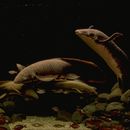Diagnostic Description
(
الإنجليزية
)
المقدمة من Fishbase
Body stout and elongate. Dorsal fin originating on the middle of the back, confluent with caudal and anal fins. Body covered with large, bony, overlapping scales. The head is flattened, with conical profile. The eyes are small; the mouth is reaching about half the distance to eye. The pectoral fins are large and flipper-like in ventral position just behind the head; the pelvic fins are also flipper-like, situated far back on the body.
Life Cycle
(
الإنجليزية
)
المقدمة من Fishbase
The lungfish spawns from August to October; the eggs resemble small transparent grapes and are frequently found attached to floating stands of water-hyacinth. Spawning appears to occur in a series of three phases: in the first, a pair of fish move together, roaming about an area, presumably in search of a suitable spawning site; in the second presumably the male follows the female, nudging her flanks; finally, the fish plunge through the surrounding weed, the male following the female and fertilising the eggs as they are shed.
Migration
(
الإنجليزية
)
المقدمة من Fishbase
Potamodromous. Migrating within streams, migratory in rivers, e.g. Saliminus, Moxostoma, Labeo. Migrations should be cyclical and predictable and cover more than 100 km.
- Recorder
- Crispina B. Binohlan
Morphology
(
الإنجليزية
)
المقدمة من Fishbase
Dorsal spines (total): 0; Dorsal soft rays (total): 0; Analspines: 0; Analsoft rays: 0
Biology
(
الإنجليزية
)
المقدمة من Fishbase
Inhabits mud, sand or gravel bottoms (Ref. 44894). Sluggish species that prefers still or slow-flowing waters, usually in deep pools. During period of drought, it can tolerate stagnant conditions by breathing air, surfacing 1-2 times per hour; however, it lacks the ability to survive dry spells by aestivation; it is a facultative air-breather that will die if forced to depend on air breathing (Ref. 36739, 44894). The sound of the lungfish exhaling air at the surface prior to inhaling a fresh breath has been likened to that made by a small bellows. Nocturnally active (Ref. 44894). Feeds on frogs, tadpoles, fishes, shrimp, earthworms, snails, aquatic plants and native fruits fallen from trees overhanging the creeks (Ref. 36739, 44894). It browses among the detritus, using its electroreceptors to pick up hidden mollusks, worms or crustaceans. Protected by law. Fossil records show that this species remained virtually unchanged for over 380 million years. The Steinhart Aquarium in San Francisco had a specimen of 1 m length, 20 kg weight, and more than 65 years of age. In 1933, an Australian lungfish was transported as a fully mature male (10 yrs. old at maturity) to the Shedd Aquarium, Chicago (C. Skonieczny, pers. comm. 11/08, e-mail: CSkonieczny@sheddaquarium.org). But this fish named Granddad, died in 2017 at the age of 95 (Ref 125841). By default, another individual which was brought to the California Academy of Sciences Aquarium in 1938 from Australia becomes the oldest at the age of 90 years. Biologists at the aquarium believe that Methuselah, as it is fondly called, is a female which measures 120 m and weighs 18,100 g (Ref. 125841).
- Recorder
- Crispina B. Binohlan
Importance
(
الإنجليزية
)
المقدمة من Fishbase
fisheries: subsistence fisheries
- Recorder
- Crispina B. Binohlan

